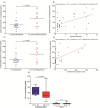Pilot study of cerebrospinal fluid biomarkers reveals inflammatory changes in patients with paranoid schizophrenia
- PMID: 40754554
- PMCID: PMC12319074
- DOI: 10.1038/s41598-025-13367-8
Pilot study of cerebrospinal fluid biomarkers reveals inflammatory changes in patients with paranoid schizophrenia
Abstract
Paranoid schizophrenia is a severe mental illness with both positive and negative symptoms. Currently, the role of peripheral and central inflammation is increasingly suspected as possible factor in the pathogenesis of schizophrenia. This retrospective, monocentric pilot study investigated 35 patients (15/35 female) diagnosed with paranoid schizophrenia after exclusion of possible underlying neuroinflammatory disorders to assess for inflammatory changes of the cerebrospinal fluid (CSF) and associated signs of neurodegeneration. Kappa free light chains (KFLC), a panel of 21 cyto- and chemokines, and neurofilament light chains (NFL) as surrogate parameters for neuro-inflammation and -degeneration were determined in patients with paranoid schizophrenia as well as age- and sex-matched inflammatory (n = 35) and non-inflammatory controls (n = 40). Patients with paranoid schizophrenia exhibited significantly higher intrathecal synthesized fractions of KFLC than non-inflammatory controls. KFLC-positive patients with paranoid schizophrenia had significantly higher NFL concentrations in CSF than KFLC-negative patients according to Reiber´s diagram. NFL concentrations in CSF of patients with paranoid schizophrenia were associated with illness duration, frequency of psychotic episodes, and amount of antipsychotic treatment attempts. This pilot study highlights inflammatory changes in the CSF among a specific subgroup of patients with paranoid schizophrenia, positively correlating with elevated NFL levels in CSF.
Keywords: Cerebrospinal fluid; Chemokines; Cytokines; Kappa free light chains; Neurofilament light chains; Paranoid schizophrenia.
© 2025. The Author(s).
Conflict of interest statement
Declarations. Competing interests: The authors declare no conflict of interest. PSG, SNT, SS, HF, SB, AH, DL, NH, JW state that there are no conflicts of interest. Outside the submitted work, some authors received honoraria for lectures, travel grants, or research grants. FFK received travel grants from Merck and Novartis. HBM took part in an educational event sponsored by Livanova. HT has participated in meetings sponsored by or received honoraria for acting as an advisor/speaker for Alexion, Bayer, Biogen, Bristol-Myers Squibb, Celgene, Diamed, Fresenius, Fujirebio, GlaxoSmithKline, Horizon, Janssen-Cilag, Merck, Novartis, Roche, Sanofi-Genzyme, Siemens, and Teva. JG has received research funding from the German Federal Ministry of Education and Research, German Science Foundation, and speaker fees from Lundbeck, Janssen-Cilag, Lilly and Boehringer. AN received lecture fees from Novartis and Merck. BM has received speakership fees from Rovi and Recordati. TS reports research support from Alnylam Pharmaceuticals, Bristol-Myers Squibb Foundation for Immuno-Oncology, Claudia von Schilling Foundation, CSL Behring, Else Kröner Fresenius Foundation, Sanofi Genzyme, VHV Stiftung and honoraria for lectures and travel grants from Alexion, Alnylam Pharmaceuticals, Bayer Vital, Biogen, Celgene, Centogene, CSL Behring, Euroimmun, Janssen, Merck Serono, Novartis, Pfizer, Roche, Sanofi, Siemens, Sobi, Teva; all outside the submitted work. All other authors have not received honoraria for lectures, travel grants, or research grants outside the submitted work. Ethics approval and consent to participate: The investigation was approved by the Ethics Committee of MHH (No. 10417_BO_K2022, 08.06.2022; No. 7837_BO_K_2018, 6 April 2018) and followed the rules of the Declaration of Helsinki of 1975 and its revisions. This is a retrospective study and only data were included that were evaluated for patients treatment or diagnostic purposes as part of the clinical routine. Thus, the local Ethics Committee of MHH waived the need for written informed consent from the participants. The data used in this study was anonymized before its use.
Figures

Similar articles
-
Kappa Free Light Chain Index Correlates With Prognostic Biomarkers in Multiple Sclerosis and Decreases Slowly Following Treatment.Eur J Neurol. 2025 Jul;32(7):e70291. doi: 10.1111/ene.70291. Eur J Neurol. 2025. PMID: 40643211 Free PMC article.
-
Alteration patterns of peripheral concentrations of cytokines and associated inflammatory proteins in acute and chronic stages of schizophrenia: a systematic review and network meta-analysis.Lancet Psychiatry. 2023 Apr;10(4):260-271. doi: 10.1016/S2215-0366(23)00025-1. Epub 2023 Feb 27. Lancet Psychiatry. 2023. PMID: 36863384
-
KFLC to Total CSF Protein Ratio Is an Alternative to KFLC Index to Diagnose Multiple Sclerosis: A Retrospective Study of 814 Cases.Neurol Neuroimmunol Neuroinflamm. 2025 Sep;12(5):e200451. doi: 10.1212/NXI.0000000000200451. Epub 2025 Jul 22. Neurol Neuroimmunol Neuroinflamm. 2025. PMID: 40694730 Free PMC article.
-
Neurofilament light chain reference values in serum and cerebrospinal fluid: a bi-compartmental analysis in neurological diseases.J Neurol. 2025 Jul 25;272(8):535. doi: 10.1007/s00415-025-13271-1. J Neurol. 2025. PMID: 40711597 Free PMC article.
-
Neurofilaments in Sporadic and Familial Amyotrophic Lateral Sclerosis: A Systematic Review and Meta-Analysis.Genes (Basel). 2024 Apr 16;15(4):496. doi: 10.3390/genes15040496. Genes (Basel). 2024. PMID: 38674431 Free PMC article.
References
-
- Jauhar, S., Johnstone, M. & McKenna, P. J. Schizophrenia. Lancet399(10323), 473–486. 10.1016/S0140-6736(21)01730-X (2022). - PubMed
-
- Hoffman, R. E. & Dobscha, S. K. Cortical pruning and the development of schizophrenia: a computer model. Schizophr Bull.15 (3), 477–490. 10.1093/schbul/15.3.477 (1989). - PubMed
-
- Kraepelin, E. Dementia praecox and paraphrenia. J. Nerv. Ment. 54 (4), 384 (1921).
MeSH terms
Substances
LinkOut - more resources
Full Text Sources

